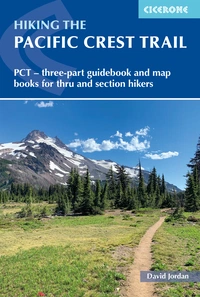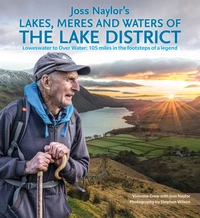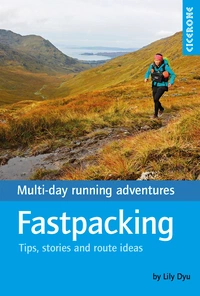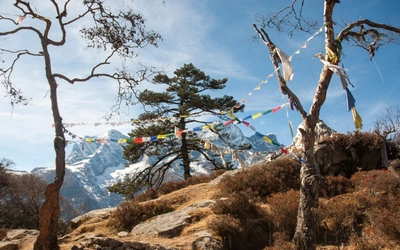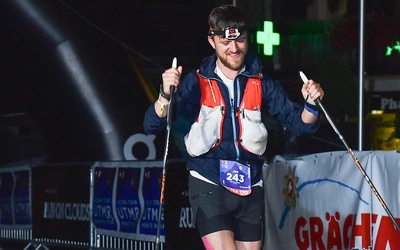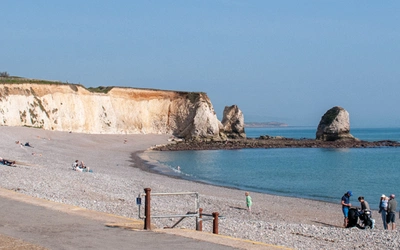True grit on the Chilkoot Trail
Brendan Sainsbury follows the Chilkoot Trail, an epic land route stretching for 53km from Dyea in Alaska to Lake Bennett in Canada, sometimes referred to as history’s last great adventure
It was late June and patches of slippery snow slowed my progress to a geriatric shuffle as I crested the 1146m Chilkoot Pass on the border between Alaska and British Columbia. I dipped my hand into my backpack, scooped out my phone and snapped the frosty scene for posterity – a misty cleft in the mountains marked by a memorial stone beyond which lay the yawning vastness of Canada.
In the 1890s, scores of hopeful prospectors scrambled across these boulder-strewn slopes weighed down by heavy baggage, hot with a fever for Yukon gold, a precious metal that most of them would never see. Over a century later, my quest was a little less dramatic. I had a train to catch at 2:10pm and, if I missed it, there wouldn’t be another one for 24 hours.
The Chilkoot trail follows the epic land route undertaken by over 30,000 ‘stampeders’ on their way to the Klondike gold fields in 1897–8. Stretching for 53km from Dyea, near Skagway in Alaska to Lake Bennett in Canada, it’s sometimes referred to as history’s ‘last great adventure’, a final swansong before planes, trains and cars sucked the intrepidness out of long-distance travel.
Gold had first been discovered on a tributary of the Klondike River in the Yukon in August 1896. When news of the strike filtered back to the US, a country caught in the midst of a crushing recession, the reaction was instantaneous and dramatic. A stampede of enthusiastic prospectors began to gravitate west to Seattle where they jumped on overcrowded ships steaming north to Alaska.

Disembarking at Skagway, they dragged their hastily gathered equipment along the Chilkoot trail as far as Lake Bennett, where they cut down trees and built boats and rafts to take them down the Yukon River to Dawson City. Most of the would-be miners were callow and naïve office workers with little outdoor experience. While few got their hands on gold, many encountered life-changing epiphanies on the gruelling journey to their destination.
Inspired by Jack London's legendary Klondike Tales, more than 3000 modern hikers spend up to four days trekking the Chilkoot’s rugged route every summer in a bid to recreate the can-do spirit of the erstwhile stampeders. Pumped full of Jack London stories, I decided to join them. But rather than walk the distance, I elected to run it in a day. The catch? The only economical way off the trail (which ends miles from the nearest road at Lake Bennett) is by train. I couldn’t afford to miss it!
Getting an early start was essential. Fortunately, I had elected to do the trek in late June when southern Alaska enjoys around 22 hours of daylight. Delivered by a magnanimous taxi-driver to the trailhead at Dyea by 4am, I set off at a light jog following the well-trodden path into the forest.
Encased in the Klondike Gold Rush National Historical Park, a protected area run jointly by the Canadian and US National Park Services, the Chilkoot trail is a giant outdoor museum scattered with the remnants of the 19th century’s most famous gold rush: iron skeletons of boats, downed tools, old shoes, and twisted cables litter the mountainous terrain.
To preserve its historical integrity, no artefacts are allowed to be removed from the trail, while to avoid overcrowding, the number of hikers is capped at 50 per day during the short summer season (June–September).
As I wasn’t camping, I was given a wild card and qualified for a cheaper trail permit ($11 versus $55). Notwithstanding, I was still required to arrive in Skagway a day early and sit through an obligatory orientation video, which included a sobering commentary on bears.
Although runners on the Chilkoot trail aren’t unheard of, they’re far from common. There’s plenty of information for multi-day hikers, but surprisingly little for fleet-footed visitors. How technical was it? I wondered nervously as I constructed a mountain of peanut butter and jam sandwiches in my hotel room the night before. Had I packed sufficient food? Was 10 hours enough?
Several kilometres out of Dyea, my nervous energy finally started to dissipate as I settled calmly into my stride and began to soak up the backcountry atmosphere. The surrounding solitude was welcome and unexpected. The cap on daily hikers coupled with my early start meant that I didn’t see another person until Sheep Camp at 21km.
In its early stages, the trail parallels the Taiya River, cutting through a thick potpourri of spruce, hemlock and cottonwood. At Beaver Pond at the 5km mark, the terrain briefly opens up with the path crossing a wetlands area where I trotted over a series of well-constructed boardwalks. Burrowing back into the forest, I soon arrived at the quiet campground of Canyon City at 12.5km.

Rugged and remote, the Chilkoot trail today feels like a re-wilding project way ahead of its time. Amid such green and tranquil surroundings, it’s hard to imagine the clamour of yesteryear. During the gold rush, Canyon City was home to a raucous settlement that included eight hotels, five taverns and an itinerant population numbering in the thousands. Today, it’s eerily deserted save for a rusting steam boiler and the foundations of some long-abandoned buildings.
After breakfasting on a power bar washed down with an energy drink, I pressed on. At Sheep Camp, I caught up with some of the previous day’s hikers, most of them still asleep in their tents, which they’d pitched on a series of raised wooden platforms beneath the forest canopy.
The only conscious human I encountered was a US park ranger who, after double-taking my light daypack, informed me that the path ahead would soon break out of the trees and embrace rocky tundra.
Back in the 1890s, most of the prospectors abandoned their horses at Sheep Camp and continued on foot. It was the only option. From here, the trail becomes significantly steeper and more menacing. Climbing swiftly, I began to catch other hikers, bobbing shadows in sodden rain-gear trudging in groups of twos and threes weighed down by their heavy backpacks. Overhead, the weather was damp and cloudy, the sky a mass of bruised clouds, the mountains mere suggestions in the mist.

The next landmark is known as ‘The Scales’, a small open basin at the bottom of Chilkoot Pass where several long since dismantled tramways once transported heavy supplies up the precipitous slope. Canadian law required all prospectors to bring at least one tonne of equipment into the Yukon – enough to keep them supplied and alive for a year.
Lugging everything in one trip was impossible. As a result, many stampeders had to tramp up and down the trail countless times to relay their goods: 53km could quickly turn into 1000km - or more.
The Scales was where they weighed their gear and worked out how much duty they would have to pay at the border. It was also the backdrop to the gold rush’s most famous photograph: a long unbroken line of ant-line figures stretching up to the snowy summit of Chilkoot Pass.
It’s impossible to run between the Scales and the pass, even in June. The ultra-steep slope is scattered with giant boulders. Reluctantly, I was slowed to a crab-like scramble using my hands for support while looking out for sporadic Inuksuks (indigenous cairns) to guide me up the indistinct route. After 30 minutes of concerted effort, I arrived gasping at a false summit, before catching my breath and stumbling through misty snow to the international frontier.
A small wooden hut, not much larger than an outhouse, marks what is possibly the strangest border post in North America. I scrambled over and stuck my head around the door to announce my presence. The resident park ranger seemed to have already received news of my imminent arrival and quickly ushered me on my way. I entered Canada without even showing my passport.

The terrain on the Canadian side of the pass is markedly different to the US: a high, treeless plateau sprinkled with mossy rocks and small lakes. For the first time, I could see wide open spaces stretching out in front of me. Enjoying elongated flat and downhill sections, I overtook a couple of small hiking parties, listening to their heavy breathing and watching their eyes fixate jealously on my light pack.
Succumbing to thirst, I stopped and filled up my water bottle in a clear stream, lacing it with two purification tablets, before wolfing down a couple of peanut butter and jam sandwiches while reactivating a fast walk. Time was ticking and the train wouldn’t wait.
Beyond Deep Lake, the second campground in Canada, the forest starts to reappear. The trees are different on this side of the pass – a subalpine melange of lodgepole pine, willow, and aspen. As I descended beneath the canopy, it felt dryer and less dense, better for spotting bears (although I’d yet to see one). Dropping further down, the path began to parallel a deep gorge with the sound of a gushing river far below. Gorgeous Lindeman Lake glimmered in the distance.
Lindeman is home to a campground and a bunch of rusty artefacts relating to the gold rush. 125 years ago, thousands of Klondikers pitched their tents at this idyllic spot. These days, overnight campers are limited to 19. The campground marks the trail’s 42km mark. I’d notched up a marathon - and it wasn’t even midday. Thankfully for my tired legs, the end was in sight.
The last 11 undulating kilometres took on the protracted, purgatorial feel of a crippling ultra-run. Fortunately. I was well inside my 10-hour cut-off time and – short of twisting an ankle – was adamant I’d make my train. I started to picture the deluxe carriages – cool leather seats, regal furnishings, a fancy dining car - like something out of an Agatha Christie novel. I must have been hallucinating.
At last, the dark calm waters of Lake Bennett came into view. It seemed like a strange terminus for one of America’s most emblematic hikes. An unusual wooden church is all that remains of the brief settlement that once graced this secluded corner of British Columbia. Guarding over it is a campground and an isolated train station that might have sprung from a Spaghetti Western.
While Bennett may have been my endpoint, for thousands of prospectors it was only the end of the beginning. There was still another 650km to go before Dawson City and the Klondike proper, a dangerous crapshoot through the turbulent waters of the Yukon River.
As the heavily laden stampeders poured into Bennett throughout the spring of 1898, a massive 15,000-strong tent city sprang up on the lake’s southern shore. Further progress was impossible until the ice melted. When the waters finally relented on 29 May 1898, over 7000 wooden boats and rafts set off en masse for Dawson City like a bedraggled Spanish Armada. It must have been a sight to behold.

The main sight for me was the arrival of my train, which pulled into the quaint wooden station a good 40 minutes early. With a final burst of adrenalin, I jumped athletically on board and found my reserved seat among the gathered tourists who’d got on in Carcross 45km down the line.
It came with a life-saving hiker’s lunchbox. The food was simple but weirdly delicious and the view was nothing short of spectacular as we chugged slowly back to Skagway through the steep emerald chasm of White Pass. Maybe it was the endorphins, but it was possibly the finest train ride I’ve ever been on.
As the loco pulled into Skagway station and everybody reluctantly disembarked, I couldn’t help but think of the ghostly fellow travellers I’d left behind. Of the tens of thousands of Klondike prospectors who rode, trekked and paddled their way to the Yukon in 1897-98, precious few found gold and even fewer made their fortune. But, for the vast majority, Klondike was a life-affirming rite of passage, a last great adventure before returning home to the promise of routine and normalcy.
I was just glad I had been able to get a small 21st century taste of it.

